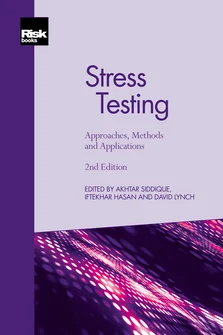Response to Financial Crises: The Development of Stress Testing over Time
Foreword
Introduction
Response to Financial Crises: The Development of Stress Testing over Time
Stress Testing and Other Risk Management Tools
Econometric Pitfalls in Stress Testing
Stress-testing applications of Machine Learning Models
Four Years of Concurrent Stress Testing at the Bank of England: Developing the Macroprudential Perspective
Stress Testing for Market Risk
The Evolution of Stress Testing Counterparty Exposures
Liquidity Risk: The Case of the Brazilian Banking System
Operational Risk: An Overview of Stress-testing Methodologies
Peacetime Stress Testing: A Proposal
Stress-test Modelling for Loan Losses and Reserves
A New Framework for Stress Testing Banks’ Corporate Credit Portfolio
EU-wide Stress Test: The Experience of the EBA
Stress Testing Across International Exposures and Activities
The Asset Market Effects of Bank Stress-test Disclosures
An Alternative Approach to Stress Testing a Bank’s Trading Book
Determining the Severity of Macroeconomic Stress Scenarios
Governance over Stress Testing
The seemingly simple idea of identifying what would happen to the portfolio of a bank if a particular event happens has become an elaborate and complex undertaking by financial institutions. In this chapter, we will look at how this straightforward concept has evolved since the thrift crisis of the 1980s. The simple approach of identifying what would happen if interest rates changed in a particular way has developed into a tool that can determine capital requirements and inform investors of the weaknesses of a bank, as well as to distinguish weaknesses in the financial system as a whole.
THE THRIFT CRISIS AND INTEREST RATE RISK
The earliest forms of firm-wide stress testing occurred in the area of interest rate risk. In the early 1980s, many savings and loans suffered large losses after interest rates rose sharply, setting off the thrift crisis that eventually required a US$150 billion taxpayer bailout (Curry and Shibut, 2000). The large losses suffered by the thrifts can be partially attributed to the large mismatch in maturity between short-term deposits and long-term loans. As a result, the savings and loan crisis of the 1980s spurred an improvement in the measurement of
Copyright Infopro Digital Limited. All rights reserved.
As outlined in our terms and conditions, https://www.infopro-digital.com/terms-and-conditions/subscriptions/ (point 2.4), printing is limited to a single copy.
If you would like to purchase additional rights please email info@risk.net
Copyright Infopro Digital Limited. All rights reserved.
You may share this content using our article tools. As outlined in our terms and conditions, https://www.infopro-digital.com/terms-and-conditions/subscriptions/ (clause 2.4), an Authorised User may only make one copy of the materials for their own personal use. You must also comply with the restrictions in clause 2.5.
If you would like to purchase additional rights please email info@risk.net











